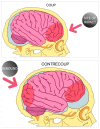Mild-to-Moderate Traumatic Brain Injury: A Review with Focus on the Visual System
- PMID: 35736619
- PMCID: PMC9227114
- DOI: 10.3390/neurolint14020038
Mild-to-Moderate Traumatic Brain Injury: A Review with Focus on the Visual System
Abstract
Traumatic Brain Injury (TBI) is a major global public health problem. Neurological damage from TBI may be mild, moderate, or severe and occurs both immediately at the time of impact (primary injury) and continues to evolve afterwards (secondary injury). In mild (m)TBI, common symptoms are headaches, dizziness and fatigue. Visual impairment is especially prevalent. Insomnia, attentional deficits and memory problems often occur. Neuroimaging methods for the management of TBI include computed tomography and magnetic resonance imaging. The location and the extent of injuries determine the motor and/or sensory deficits that result. Parietal lobe damage can lead to deficits in sensorimotor function, memory, and attention span. The processing of visual information may be disrupted, with consequences such as poor hand-eye coordination and balance. TBI may cause lesions in the occipital or parietal lobe that leave the TBI patient with incomplete homonymous hemianopia. Overall, TBI can interfere with everyday life by compromising the ability to work, sleep, drive, read, communicate and perform numerous activities previously taken for granted. Treatment and rehabilitation options available to TBI sufferers are inadequate and there is a pressing need for new ways to help these patients to optimize their functioning and maintain productivity and participation in life activities, family and community.
Keywords: head injury; prognosis; retina; traumatic brain injury; vision.
Conflict of interest statement
The authors declare no conflict of interest.
Figures


References
-
- Centers for Disease Control and Prevention National Center for Health Statistics: Mortality Data on CDC WONDER. [(accessed on 20 April 2022)]; Available online: https://wonder.cdc.gov/mcd.html.
Publication types
LinkOut - more resources
Full Text Sources

